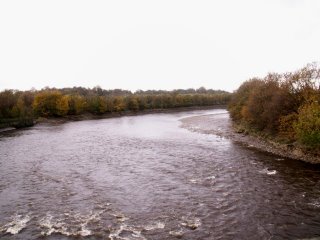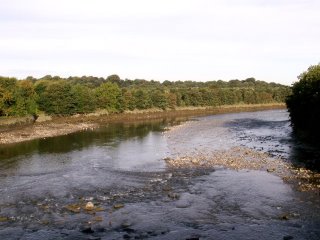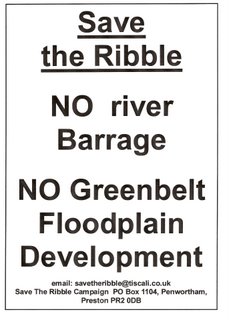Planning Review: A New Threat to the River Ribble and Our local Green Belt?

Pink-footed geese at RSPB Marshside.
Save the Ribble Campaign are concerned that recommendations contained in the HM Treasury-commissioned Planning Review could further threaten our River and Green Belt by making it easier for Preston City Council to pursue its Riverworks project.
Not surprisingly for a report written by the Bank of England policy maker Kate Barker, the emphasis of the review is on removing uncertainties to accelerate decision-making around major planning projects to the benefit of business interests and economic growth. It recommends that planning applications should be approved unless there are strong reasons against them, and that streamlining the planning process could save businesses and local authorities hundreds of millions of pounds.
The Institute of Directors has welcomed the report as “one of the most sensible things to have come out of the Treasury in years.”
The Campaign to Protect Rural England is concerned that, in the Review, “overall there is a worryingly strong emphasis on enabling local councils and communities to reap more financial rewards from new development – in the belief that this will make them adopt more pro-growth and pro-development attitudes” (Campaign to Protect Rural England ).
As The Guardian points out in its own coverage of the impact of the Barker report, environmental organisations are concerned that its proposals 'would have a "devastating impact on the environment and local democracy" if they allowed more out-of-town shopping developments or house building to proceed on land protected for more than 40 years by strict planning laws'.
The Guardian illustrates these concerns in a case study of the Save The Ribble Campaign: see today's Guardian story Ripples of Discontent on the Ribble.

Penwortham - Walton le Dale Green Belt, an oasis of peace and tranquility 5 minutes walk from Preston City Centre.
The Report has also called for a review of urban green belt boundaries to allow for socially and environmentally “friendly” developments – it is unclear, however, what the criteria for ascertaining this is.

A misty January morning at high tide in Preston, picture by Bob W.
This emphasis in the Review is also at odds with the Governments stated aims for sustainable development, and for Biodiversity Action Plan targets.

Mud, mud, glorious mud... low tide in Penwortham.
Preston City Council may be delighted at several aspects of this review, particularly as some of the recommendations could create a planning environment which would make it easier for them to realise their Riverworks project, despite the threat it poses to local communities and wildlife on an international scale.
Preston City Council’s Riverwork’s Project includes proposals to:
- build a barrage on the River Ribble to create an artificially high water
level to create a water sports park;
- build over 4,000 new houses and businesses on the Ribble’s green belt/floodplain on both the Penwortham and Preston sides, and develop on what they consider to be an “under-utilised river valley” (PCC Lottery Bid). This area includes an existing nature reserve, meadows, woodland, allotments and amateur league football fields.

Summer wildflower meadows full of birds, butterflies, and the hum of bees.
Preston City Council uses economic arguments to justify its Riverworks project, arguing that without the barrage and massive housing development and business park, Preston and the surrounding area will enter a “spiral of decline” and become a centre “for the retired, the disadvantaged and the unemployed” (PCC Lottery Bid).
Arguments have also been made for the strategic release of green belt to enable the creation of urban development along the River valley (Central Lancashire Sub-Regional Spatial Strategy p24).
This is all despite Preston and South Ribble already being economic growth areas:
- South Ribble is already “one of the most prosperous districts in Lancashire in terms of employment potential and wealth” (PCC Submission to Boundaries Committee for England: Proposal for a New City of Preston Council).
- Preston is already “experienc[ing] one of the fastest rates of employment growth across all NW districts in the last 4 years (+35%)… Economic forecasts for this …area suggest a growth rate over the next 10 years well in excess of the regional average” (Lancashire Economic Partnership and The Northern Way Central Lancashire City Region Development Programme p.7)
and all without causing potentially disastrous consequences to the River Ribble and surrounding Green Belt. (See Unitary Threat).

The Ribble in Autumn.

Ribble mudflats are a vital feeding ground at low tide.
Whilst the Riverworks proposals may be welcomed by business interests, the Save the Ribble Campaign considers them to be neither socially nor environmentally friendly, nor economically sustainable.
A barrage on the Ribble will threaten the most important estuarine river in Britain, if not Europe, home to internationally significant numbers of bird species, many under threat both nationally and globally, aswell as numerous fish species, including Atlantic Salmon, the tenth most threatened animal species in Europe.
The Ribble's international significance is recognised in its Specially Protected status under the Ramsar Convention and the Conservation Habitats Regulations 1994.
It will also threaten the natural flood defences of the entire Ribble estuary.
Also see DEFRA on the importance of Britains wetland habitats.

Saltmarsh on the Ribble Estuary - an internationally important habitat rarer than rainforest and under threat from sea level rises.
Building new housing and business developments on the Ribble’s green belt not only destroys valuable local amenities and wildlife habitats, such as our football fields, allotments, nature reserves, river banks, fields, meadows and woodlands, it directly threatens the safety and economic viability of the existing (and new) housing and businesses by removing the natural flood plain which currently protects the area: see also the Environment Agency
Whilst it is recognised that continuing economic growth is important, economic development which is so detrimental to the environment is not sustainable development and will cost more in the long term trying to put right the damage caused (the environmental impacts of the Cardiff Bay Barrage currently costs the Welsh Assembly more than £20 million every year).
Economic wealth is also not the only determinant of quality of life, and it is increasingly recognised that quality of life is determined and measured by access to our natural and unspoilt environment (Government Quality of Life Counts Report).
We do share CPRE’s welcome of some aspects of Kate Barkers Review, as, ‘despite the economic bias of its remit, it recognises that the planning system does have a critical, multi-faceted role in protecting the environment. It also makes the case for continuing to focus new development on under-used or derelict land within our existing towns and cities.’ (CPRE ). The fact remains, however, that what constitutes ‘under-used land’ for a developer isn’t necessarily under-used by the local community or by wildlife.
Much of this Review appears to reflect the worst aspects of the decades of unsustainable developments which have pushed our local communities, and the sustainability of our global, national, and local environment to the brink of disaster – and as such, echoes Preston City Council’s approach to the Ribble and green belt NOT as the richest intertidal habitat in the UK but as “bleak, barren, and undeveloped” (Riverworks 01) and therefore ripe for development.

Redshank in Broadgate, Preston, picture by Greg.
You can contact us at savetheribble@tiscali.co.uk















0 Comments:
Post a Comment
<< Home